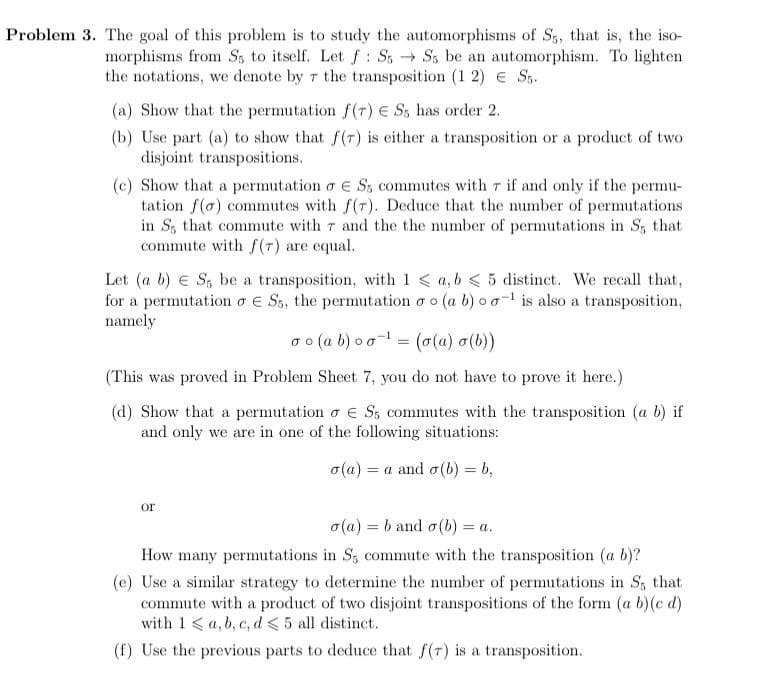(b) Use part (a) to show that f (T) is either a transposition disjoint transpositions. or a product of two
(b) Use part (a) to show that f (T) is either a transposition disjoint transpositions. or a product of two
Elements Of Modern Algebra
8th Edition
ISBN:9781285463230
Author:Gilbert, Linda, Jimmie
Publisher:Gilbert, Linda, Jimmie
Chapter3: Groups
Section3.3: Subgroups
Problem 26E: Let A be a given nonempty set. As noted in Example 2 of section 3.1, S(A) is a group with respect to...
Related questions
Question
prob 3 part f
plz provide handwritten solution for part B asap

Transcribed Image Text:Problem 3. The goal of this problem is to study the automorphisms of S, that is, the iso-
morphisms from S5 to itself. Let f: S5 Ss be an automorphism. To lighten
the notations, we denote by r the transposition (1 2) € S,.
(a) Show that the permutation f (7) E S, has order 2.
(b) Use part (a) to show that f(r) is either a transposition or a product of two
disjoint transpositions.
(c) Show that a permutation o E S, commutes with 7 if and only if the permu-
tation f(o) commutes with f(7). Deduce that the number of permutations
in S, that commute with 7 and the the number of permutations in S, that
commute with f(r) are equal.
Let (a b) e S, be a transposition, with 1 < a, b < 5 distinct. We recall that,
for a permutation o e Ss, the permutation o o (a b) o01 is also a transposition,
namely
o o (a b) o o- = (0(a) o(b))
(This was proved in Problem Sheet 7, you do not have to prove it here.)
(d) Show that a permutation o e S; commutes with the transposition (a b) if
and only we are in one of the following situations:
o(a) = a and o(b) = b,
%3D
%3D
or
a(a) = b and o (b) = a.
%3D
How many permutations in S; commute with the transposition (a b)?
(e) Use a similar strategy to determine the number of permutations in S, that
commute with a product of two disjoint transpositions of the form (a b)(c d)
with 1< a, b, c, d < 5 all distinct.
(f) Use the previous parts to deduce that f(r) is a transposition.
Expert Solution
This question has been solved!
Explore an expertly crafted, step-by-step solution for a thorough understanding of key concepts.
Step by step
Solved in 2 steps with 2 images

Recommended textbooks for you

Elements Of Modern Algebra
Algebra
ISBN:
9781285463230
Author:
Gilbert, Linda, Jimmie
Publisher:
Cengage Learning,

Linear Algebra: A Modern Introduction
Algebra
ISBN:
9781285463247
Author:
David Poole
Publisher:
Cengage Learning

Elements Of Modern Algebra
Algebra
ISBN:
9781285463230
Author:
Gilbert, Linda, Jimmie
Publisher:
Cengage Learning,

Linear Algebra: A Modern Introduction
Algebra
ISBN:
9781285463247
Author:
David Poole
Publisher:
Cengage Learning